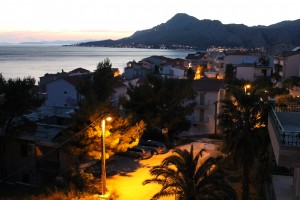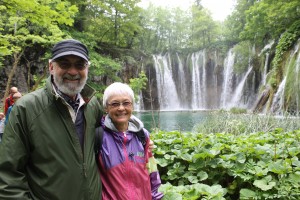Croatia (pt 2)
Sunday, June 8th, 2014Left our sobe with a nice view near Ravanjska. Stopped for coffee and donuts near a fish sellers stand then drove on to Zadar where we stopped briefly. Walked along the city walls and waterfront. Heard the “sea organ” – pipes in the seawall at various lengths creating music as the waves washed through them. Interesting. Basically spent the day meandering along the coast and stopping often for the views. Stopped in a small village for lunch and hiked along the stony shore for a while.
Discovered another small village near Omis along the coast where we found an “apartment” for the night—4th floor with a balcony overlooking the water.
Doing a lot of meandering along the road—stopping often for photo shots. The scenery is beautiful—mountains, blue water, blue sky, rocky shores, colorful wildflowers, small villages with red tile roofs, sailboats, olive orchards, and vineyards. Drove up the Peljesac peninsula turning off the main road to explore small villages. Stayed in Trstenik for two nights in small apartment with a balcony overlooking the water. Nice and quiet with beautiful views.
Drove to the far end of the peninsula, again admiring the scenery. Chose a footpath along the mountainside exploring the plants and old buildings along the way. Walked 7-8 kilometres in the bright sun.
The morning that we left the peninsula we stopped in Ston to walk along the longest medieval stone wall in Europe—about 5 km. It is very steep and very impressive. It was built in the 14th – 115th centuries. It was quite a feat to build it and we felt that it was quite a feat for all of us to walk/climb it.
On to Dubrovnik. Again we stayed in a family sobe. Our view may not have been spectacular but the hosts were very friendly and helpful. Dubrovnik was a major maritime power 500-600 years ago. Today it is a major tourist center. The city is ringed by thick medieval walls; has narrow, steep alleys, and displays much history. It was virtually destroyed by two earthquakes in the 1500s and 1600s, rebuilt, again destroyed in the 1991-1995 war, and again rebuilt. We walked/climbed ¾ of the mile-long walk on the wall, visited Catholic and Orthodox churches, and rode a cable car to the top of Mt Srd with its fortress overlooking the city.
- near Ravanjska
- near Ravanjska
- coffee and donuts
- fish stand
- Zadar
- sea organ
- Zadar
- Zadar
- coastal view
- poppies
- coastal view
- room view near Omis
- coastal view
- coastal view
- fruit stand
- village on Peljesac peninsula
- room view in Trstenik
- dinner in Trstenik
- view from Peljesac peninsula
- vineyard
- hiking on Peljesac peninsula
- view on hike
- lunch on hike
- ruins along hike
- view on hike
- medieval wall in Ston
- climbing wall
- on top of tower
- descending section
- view of Ston
- on the wall
- descending
- view down other side
- reward lunch after climb
- our hosts in Dubrovnik
- Dubrovnik old city
- musician
- Dubrovnik old city
- Dubrovnik old city
- tourists !
- tourists !
- old city wall
- Dubrovnik old city
- Dubrovnik old city
- tower
- Dubrovnik old city
- cistern
- Dubrovnik old city
- Dubrovnik old city
- lunch time
- overlooking Dubrovnik
- overlooking Dubrovnik
- cross high over Dubrovnik
- Dubrovnik old walled city






















































































